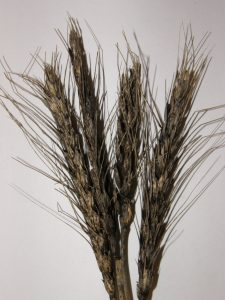Bulletin #1020, Sooty Mold of Barley and Other Small Grains
Bulletin #1020, Sooty Mold of Barley and Other Small Grains (PDF)
By Steven B. Johnson, Extension crops specialist, University of Maine Cooperative Extension
For information about UMaine Extension programs and resources, visit extension.umaine.edu.
Find more of our publications and books at extension.umaine.edu/publications/.
Sooty mold of barley and other small grains can be caused by a number of fungal species, including Alternaria, Cladosporium, Stemphylium, or Epicoccum. These can be weakly parasitic, but generally, are saprophytic fungi that colonize dying plant parts when conditions are favorable. In Maine, Cladosporium spp. is the dominant species causing sooty mold. Sooty molds are not limited to small grains and have a worldwide distribution. While the effects of sooty mold are generally not thought to be economically important, the symptoms can increase markedly with delayed harvest under wet and warm conditions. Crops that are weakened by poor nutrition, insect damage, or disease are more susceptible to sooty mold than healthy, pest-free crops. The appearance of severe sooty mold can result from crop-production problems or delayed harvest.
Symptoms
Other cereal-head diseases differ in that they are more than just superficial. Sooty-mold-affected grain heads have black discoloration and are covered with sooty-looking mold, giving them a weathered appearance. In cases where symptoms are not severe, only the tissue surrounding the grain is affected, but not the grain itself. In these cases, yield or test weight is not affected. Severe symptoms associated with delayed harvest can result in lesions on the kernels and this can reduce the quality of the harvested grain. Harvest releases spores from the sooty-mold-infected seed heads. In crops with high levels of sooty mold, combines may be dirty and dusty and covered with released spores, which can be an indicator of high levels of sooty mold.
Management
Proper crop nutrition and pest control, combined with proper harvest timing, will keep sooty mold at a minimum.
Thanks to reviewer David Fuller, Extension Professional
Information in this publication is provided purely for educational purposes. No responsibility is assumed for any problems associated with the use of products or services mentioned. No endorsement of products or companies is intended, nor is criticism of unnamed products or companies implied.
© 2014, 2020
Call 800.287.0274 (in Maine), or 207.581.3188, for information on publications and program offerings from University of Maine Cooperative Extension, or visit extension.umaine.edu.
In complying with the letter and spirit of applicable laws and pursuing its own goals of diversity, the University of Maine System does not discriminate on the grounds of race, color, religion, sex, sexual orientation, transgender status, gender, gender identity or expression, ethnicity, national origin, citizenship status, familial status, ancestry, age, disability physical or mental, genetic information, or veterans or military status in employment, education, and all other programs and activities. The University provides reasonable accommodations to qualified individuals with disabilities upon request. The following person has been designated to handle inquiries regarding non-discrimination policies: Director of Equal Opportunity and Title IX Services, 5713 Chadbourne Hall, Room 412, University of Maine, Orono, ME 04469-5713, 207.581.1226, TTY 711 (Maine Relay System).


